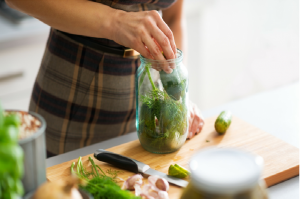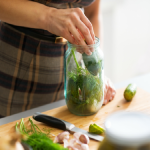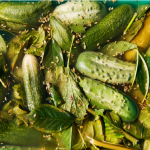Corn is making a prominent appearance at market this week, along with Pickling Cucumbers. If you’ve ever had the desire to try your hand at your own signature pickles (maybe you like them spicy, extra dilly, or lacto-fermented), now is the time!
Additionally, our farmers have Peaches, Melons, Blueberries and a wide range of delicious Tomatoes including Heirloom, Salad, Roma and Cherry. You’ll also find multiple varieties of Green Beans (including Romano and French Filet) and Peppers (including Poblano, Anaheim Chili Peppers, Shishito and Jalapeno), plus Swiss Chard, Gladiolas and other Flowers, Carrots, Beets, Leeks, Micro-Greens, Salad Turnips, Radishes, Basil Dill, Parsley, Arugula, Garlic, Huckleberries, Walla Walla and Candy Onions, Garlic Scapes, Green Onions, Cauliflower, Broccoli, Kale, New Potatoes, Cabbage, Zucchini and Summer Squash, Celery, Cilantro and Shallots. This is the most abundant time of year for locally-grown produce!
- Music by Living Well
- Wednesday, August 16th, 4pm – 7pm
- Wednesday Market Location
- Music by Ed Graves
- Saturday, August 19th, 9am – 1pm
- Saturday Market Grounds
 DIY Pickles are Fun and Easy!
DIY Pickles are Fun and Easy!
Diana Probert with Royal Highlands has a lot of experience making pickles. With a large family and an even larger garden, she spends countless hours each year slicing, canning and tweaking recipes to preserve the crunchy abundance for the winter months. She also sells cucumbers at market – by the bag or box – for customers to create their own signature pickles. Diana wants people to know that making cucumbers is easy and fun. Here are a few of her tips, as well as 2 recipes she’s been using the past couple of weeks.
- Use small, firm cucumbers. This is, hands-down, the most important! If you start with a big old soft cucumber, you’ll end up with big old soft pickles. Always, always select the freshest, firmest cucumbers.
- Jar them as soon as possible. Don’t let them sit on the counter for days and days.
- Soak cucumbers in an ice water bath for a couple hours. If you can’t get to work canning your cucumbers immediately after you get home from the farmers’ market, submerging them in an icy bowl of water in the fridge will help them firm up/stay firm.
- Cut off the blossom end of cucumber. The blossom-end of a cucumber is said to contain enzymes which can cause mushy pickles. Cutting it off is your best bet.
- Add tannins to the jar. This may include oak leaves, grape leaves, horseradish leaves or black tea. Honestly? This trick is always recommended, but I’ve had hit-or-miss results with it… If you have oak leaves or grape leaves handy, it definitely can’t hurt to toss one in each jar. Or, add a 1/2 teaspoon of loose black tea to each jar. But again, it won’t turn already-soft cucumbers magically crispy.
There are so many ways to process pickles……. Canning them, old fashioned vinegar brine, lacto-fermenting them or just simple refrigerator pickles. Don’t be intimidated, just pick one method and give it a try. Making pickles is easy!
Editors Note: Next week’s Fresh Sheet will feature an interview with Cole Ina, The Cultured Mama, about how to ferment other types of vegetables too. Stay tuned!

- 2 cups thinly sliced pickling cucumbers
- 1 Tbsp kosher salt
- 2 Tbsp chopped fresh dill
- 1/2 cup white vinegar
-
Add cucumber slices to a clean 1-pint jar.
Add salt, dill and vinegar. Close the lid and shake to distribute ingredients. (Liquid will not cover cucumber slices. Don't worry. The salt will draw liquid from the cucumbers in a couple of hours.)
Place the jar in the refrigerator and remember to shake it once or twice in the next few hours.
In about 6 hours, you'll have delicious, crispy pickles.

This is a basic formula. You can make any size batch you wish. Using mason jars is common and you can ferment in quart, half-gallon, and gallon sizes with success.
- Salt
- Cucumbers
- Pickling Spices, garlic, onion, and/or herbs
- Leaves for crispiness
-
Prepare a brine using the ratio of two tablespoons of salt to one quart of water. If it is over 85 degrees in your kitchen, use one extra tablespoon of salt. Stir well and set aside.
Chop pickles into sticks or bite-sized pieces, or leave whole as desired.
Gather flavorings – garlic, onions, fresh herbs, or your favorite pickling spices.
Add garlic, herbs, and spices to the bottom of your clean quart, half-gallon, or gallon jar.
Add one of the following to keep your vegetables crisp: grape, horseradish, oak, or black tea (yes the kind you drink).
Place cucumbers atop flavorings, leaving at least 2 inches of headspace from the rim of the jar. Pour the brine over the cucumbers so they are covered by at least one inch. Two to four inches is even better, but hard to achieve in quart jars.
Weight down your cucumbers so they stay below the brine while fermenting. You can use small plates that will fit into the jar opening, inverted plastic jar lids, a large cabbage leaf, root vegetable slices, or glass weights made specifically for this purpose.
Cap the jar tightly and allow to sit at 65-85 degrees for around 10 days, or more, depending on your preference. The longer they ferment at room temperature, the sourer they become.
During the earliest stages of fermentation carbon dioxide is released. Check your jars once or twice a day to see if the lids are building up pressure. If you cannot press down on the canning lid as you normally would, very quickly and carefully “burp” your jar by slightly unscrewing the lid, allowing a bit of gas to escape, and screwing it back on quickly.

Leave a Reply